A recession could negatively impact manufacturers’ revenue, production, customer loyalty, and product developments.
By Jeff Cagle, Director of Global Accounts, Incentive Solutions
If you told today’s manufacturing vendors and suppliers that they should run an incentive program, many might ask “Why?” Product demand is likely high. The HVAC industry, for example, is expected to have a compound annual growth rate (CAGR) of 5.6%1 from 2022 to 2030. When the sales forecast is sunny, why worry about motivating channel partners with extra incentives? Because it’s a proactive strategy that will protect your organization when economic conditions are unfavorable.
To better understand the usefulness of incentive programs in distribution channels, let’s first get a better understanding of the market conditions B2B brands are facing. Beginning with the question on everyone’s mind…

The short answer isn’t very satisfying: no one knows for sure. Recessions aren’t easy to predict. In fact, The International Monetary Fund (IMF) has only correctly forecasted2 four out of 469 economic downturns since 1988.
The main indicators of a recession are personal income, payrolls, personal consumption, manufacturing and trade sales, employment, and industrial production. Here’s what each of them is saying according to the National Bureau of Economic Research (NBER)3:
Personal income has risen and fallen throughout 2022. Overall, though, it’s been trending toward improvement.
Payrolls have been a particularly positive indicator this year. The pace of ~450,000 jobs a month is much stronger than average, pre-COVID-19 months.
Personal consumption makes up for 70% of the U.S. economy, so it’s an important metric. Personal consumption, much like personal income, has been mixed in 2022. After drops in the second quarter, June’s 1% increase was the largest since September 20054.
Manufacturing and trade sales have been poorly performing. Manufacturers battle supply chain difficulties, while orders slowed and a stronger U.S. dollar increased exports expense.
Employment has been unsteady in 2022. After strong numbers in the first quarter, household employment dropped in April and June.
Industrial production, like many other economic indicators, has fluctuated in 2022. With a stable rate in the first quarter, May and June saw declines, while the July rate has climbed back up.
It’s a term we’re all sick of, but the best way to describe current economic conditions is “uncertain.” Positive and negative indicators don’t point strongly in one direction. But with global conflicts, labor shortages, disrupted supply chains, and the U.S.’s June inflation rate the highest since 19815, B2B brands should be proactive in their sales and marketing plans.
If there is an economic recession in store, B2B brands’ sales, revenue, production, customer loyalty, and product developments could all be negatively affected. If current economic conditions have you in a favorable place, sales wise, it’s the best time to start preparing for an uncertain future. Incentive programs launched proactively can help vendors and suppliers mitigate or avoid challenges. Here’s how:
The best incentives reward recipients with something meaningful. You can reward customers with debit cards, for example, or digital points they can spend in an online catalog with an array of merchandise options. This gives customers the power to choose rewards most motivating to them.
Rewards attach personal value to your brand. The more of this personal value your channel partners accrue, the more equity they’ll have in your incentive program. This equity helps create strong, long-lasting customer loyalty that will help your brand weather rough economic conditions.
The importance of existing B2B customers is best highlighted in these three stats:
Investing in existing customers during lucrative periods means that you can rely on your biggest revenue contributors when you need them most.
The benefit of online-based incentive program technology is that you’re not limited to sales promotions. When your channel partners are facing sales difficulties beyond their control (supply chain issues, product shortages, etc.), you can reward them for other activities. For example, rewarding channel partners for submitting warranty registrations, invoices, or customer feedback can yield customer data that helps inform more effective sales and marketing strategies.
The “invest now, enjoy stability later” approach to incentive programs is validated by past business cycles. Our clients who invested in their incentive programs in the late 1990s credited their incentive programs with helping them survive the Great Recession of 2008. With technology making incentive programs more versatile, effective, and data-driven, investing in channel partner incentives will help you create stronger bonds with your customers with a well-rounded reward experience that elevates your brand’s value.

Jeff Cagle is the Director of Global Accounts at Incentive Solutions (www.incentivesolutions.com) and OneAffiniti (www.oneaffiniti.com), where for 27 years he has helped provide B2B brands with insights on how to leverage channel incentive plans and technology.
Sources
1 https://www.grandviewresearch.com/industry-analysis/us-hvac-systems-market
2 https://www.bloomberg.com/news/articles/2019-03-28/economists-are-actually-terrible-at-forecasting-recessions
3 https://www.bloomberg.com/news/articles/2022-08-01/here-s-what-the-six-key-official-indicators-of-us-recession-show
4 https://tradingeconomics.com/united-states/pce-price-index
5 https://tradingeconomics.com/united-states/inflation-cpi
Scott Ellyson, CEO of East West Manufacturing, brings decades of global manufacturing and supply chain leadership to the conversation. In this episode, he shares practical insights on scaling operations, navigating complexity, and building resilient manufacturing networks in an increasingly connected world.